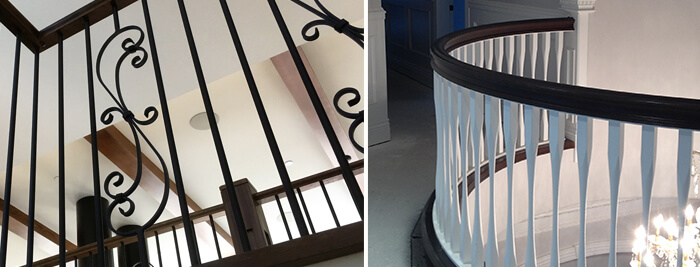Custom Staircase Balustrades Installations in Port Alberni, BC by Art Trim Woodwork

Staircase railing parts are known collectively as the balustrade, which includes the newels (or newel posts), the balusters, and the railing. Newels are the primary supports for the railing, while the balusters provide secondary support and create a barrier.
The staircase balustrades are undoubtedly the most ornamental and visually dramatic part of a staircase. The eye delights in taking it all in: the stately newel, the graceful curves of the railing, the polished surfaces, and the balusters in perfect repetition. Today, as in the past, a staircase balustrade is often the most ornate and finely crafted built-in feature of the home. The main balustrade elements (newels, railings, and balusters) are offered by stair parts manufacturers both separately and as assets. Common materials include hardwood such as oak, maple, cherry, mahogany, and poplar, as well as iron and steel. Replacing any or all of the main parts can bring a dramatic change to your staircase. However, aside from replacing individual balusters, installing balustrade parts is not a job for amateurs.
Together, railings and balusters provide an architectural definition of a staircase, in addition to their obvious functional roles. From a design standpoint, the two parts are related to the extent that the baluster’s top end must conform to the hole or groove in the baluster and must fit with the tread or curb design. But beyond that, there’s little that limits the decorative possibilities of a baluster or a railing and baluster combination.
Most railings are made of hardwood, but iron and steel are not uncommon. Railings are categorized as either over-the-post, which means the railing runs over the tops of the newels, or post-to-post, meaning the railing ends butt into the sides of the newels. The differences are primarily aesthetic, although with post-to-post railings you have to remove your hand from the railing at transitions. Where railing ends do not meet newels, decorative options include curved or mitered wall returns, decorative blocks called rosettes that receive the railing end at a wall, and half newels – a partial newel installed flush to a wall.
Installing most balusters is fairly straightforward but does require careful cutting and measuring. Balusters with rounded top ends fit into holes in the underside of the railing, while square-top styles are nailed into a groove and have thin wood plates, called fillets, applied between the balusters. Most wood balusters have square bottom ends and attach to the treads or a low curb with nails or use a dowel or tenon that fits into a hole in the tread. Some treads have a little piece of applied nosing trim covering the dowel or tenon. New baluster blanks have elongated top ends that you cut to match the slope of the railing.
Improve your space with Art Trim Woodwork’s staircase installations in Port Alberni, BC
Explore Art Trim Woodwork’s range of stylish balustrades, designed to complement your project seamlessly. Request a free quote and bring your staircase vision to life.
